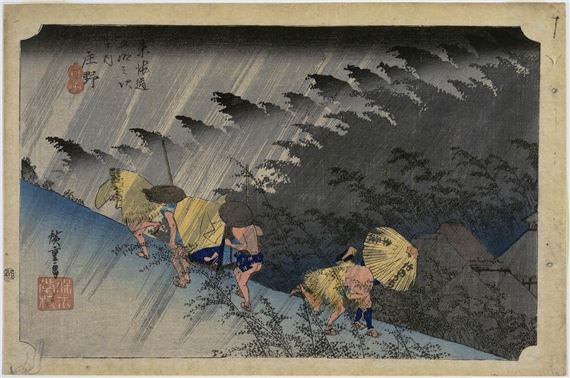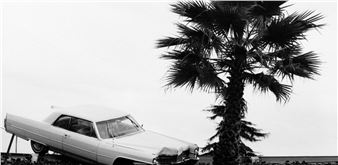Rising Sun, Falling Rain: Japanese Woodblock Prints from the Grunwald Center for the Graphic Arts
Ukiyo-e, or “pictures of the floating world,” emerged as a defining artistic genre during Japan’s Edo period (1603–1868), an era of significant cultural transformation. Initially centered on the vibrant urban life of licensed pleasure quarters—depicting kabuki theaters, teahouses, and brothels—ukiyo-e gradually expanded in subject matter in response to shifting social interests, increased domestic travel, government censorship, and contact with Western art. Themes came to include nature, landscapes, poetry, literature, and folklore.
Rising Sun, Falling Rain traces the evolution of ukiyo-e printmaking and the later shin-hanga movement, featuring over eighty prints from the Grunwald Center for the Graphic Arts by renowned artists such as Katsukawa Shunshō, Utagawa Toyokuni, Katsushika Hokusai, Utagawa Hiroshige, Tsukioka Yoshitoshi, and Kawase Hasui. These works exemplify the technical mastery and aesthetic refinement of Japanese woodblock printing, which profoundly shaped global perceptions of Japan’s cultural legacy and fostered enduring engagement with its historical narratives.

Recommended for you
Ukiyo-e, or “pictures of the floating world,” emerged as a defining artistic genre during Japan’s Edo period (1603–1868), an era of significant cultural transformation. Initially centered on the vibrant urban life of licensed pleasure quarters—depicting kabuki theaters, teahouses, and brothels—ukiyo-e gradually expanded in subject matter in response to shifting social interests, increased domestic travel, government censorship, and contact with Western art. Themes came to include nature, landscapes, poetry, literature, and folklore.
Rising Sun, Falling Rain traces the evolution of ukiyo-e printmaking and the later shin-hanga movement, featuring over eighty prints from the Grunwald Center for the Graphic Arts by renowned artists such as Katsukawa Shunshō, Utagawa Toyokuni, Katsushika Hokusai, Utagawa Hiroshige, Tsukioka Yoshitoshi, and Kawase Hasui. These works exemplify the technical mastery and aesthetic refinement of Japanese woodblock printing, which profoundly shaped global perceptions of Japan’s cultural legacy and fostered enduring engagement with its historical narratives.
Contact details


 ARTISTS
ARTISTS















